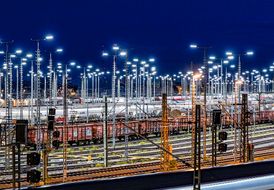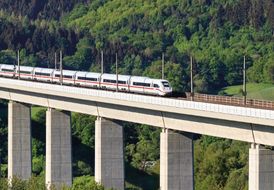Development in the relevant markets
Land transport
Europe
- After the slump in European land transport in 2020 due to the Covid-19 pandemic, there was a noticeable recovery in 2021.
- 2021 was marked by an increase in demand in European land transport as a result of the economic recovery. The increased demand was met by a shortage and an increase in the price of transport services, caused in part by a lack of drivers and an increase in the price of diesel. Prices for transport services increased noticeably, and were exacerbated by unstable supply chains in air and ocean freight and the resulting waiting times.
- Shipment flows also changed slightly from intercontinental to more intra-European flows.
- Investments in digital platforms for consolidating supply and demand of transport capacities added to the existing pressure on margins caused by intense competition.
- Despite the tense market situation, DB Schenker maintained its market-leading position.
Americas
- Truck load capacity in North America remained very low, initially mainly in the US, then also in Mexico and Canada. The ongoing lack of drivers, the availability of equipment and parts, as well as the rising costs of fuel, tires and insurance, caused prices to rise further.
- In South America, the market was less tense – disruptions to land transport were much less frequent and were caused by pandemic-related problems or general port congestion.
Asia/Pacific
- Domestic business in most countries was affected by restrictions related to the Covid-19 pandemic from February to July 2021. International business in Asia and Eurasia increased by 75%, due to restrictions in international air and shipping.
Air freight
As in the previous year, 2021 was heavily influenced by pandemic-related factors on all trade routes.
- Since the beginning of the pandemic, the air freight market has been faced with a lack of capacity, triggering strong momentum in terms of rising freight prices.
- On the geopolitical level, trade restrictions also presented further obstacles.
- Nevertheless, the market was able to increase significantly in tonnage compared to the crisis-shaken previous year. The recovery was also helped by the extreme turbulence affecting the ocean freight market. Many companies tried to compensate for supply-chain bottlenecks by using air freight. According to the international industry association IATA, demand has now exceeded pre-pandemic levels, although capacity is still significantly lower.
- DB Schenker recorded significant volume growth in 2021. This was made possible by the early purchase of charter freight capacities, which, in the current situation of scarce capacity, enables not only existing customers to ensure the smooth running of their transport chain, but also enables us to attract new customers.
Ocean freight
- The market situation remained very tense in 2021. The reliability of global schedules reached a low point, marked by delayed port arrivals, longer handling times and a record number of overbooked container spaces. This led to persistently high rates from the beginning of the year.
- This situation was caused by many far-reaching restrictions, starting with the incident in the Suez Canal, followed by the Covid-19-related closure of the terminal in the port of Ningbo and the delays in the port of Los Angeles/Long Beach, with subsequent further equipment bottlenecks and delays.
- The development of the market in 2021 was thus marked by great uncertainty for all participants.
- Thanks to preferential access to capacity, DB Schenker has held up well in this challenging market environment.
Contract logistics
- The global contract logistics market recorded a recovery in 2021, mainly from the APAC and Americas regions, while the Europe region was not able to recover to pre-pandemic levels.
- The positive development in the e-commerce, healthcare, electronics and consumer goods sectors was still very pronounced and contributed significantly to strong market growth. The situation in industry also improved significantly.
- The automotive and consumer electronics sectors experienced a short-term increase in demand volatility due to supply bottlenecks for microchips and inventories caused by capacity bottlenecks and/or delays in ocean freight.
- Stronger price increases were observed in individual segments, including wages, steel, industrial trucks, as well as other material handling equipment and real estate.
- DB Schenker recorded a slight increase in its market share due to its geographically and sectorally diversified portfolio, particularly in the Americas and Asia/Pacific regions.



